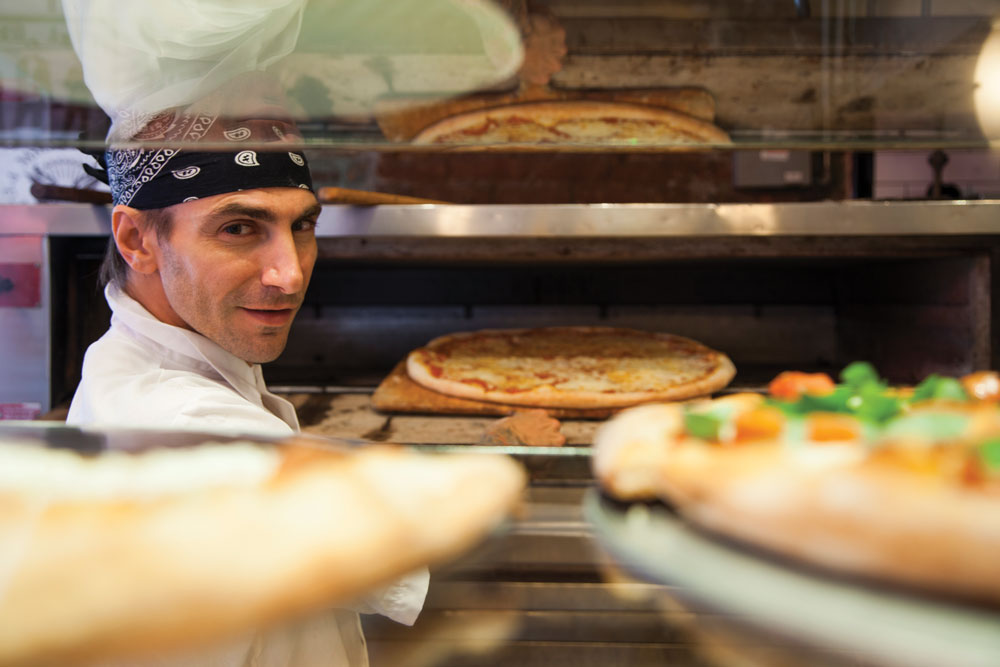New York-style pizza is an American icon.
Even those who didn’t grow up in New York or never tasted a New York slice can still recognize a New York pizza. That big, signature, foldable crust, complete with a healthy helping of part-skim mozzarella forming a satisfying river of grease down the middle, is undeniably a Big Apple original.
When pizza is featured in a blockbuster movie or TV show, New York-style pie almost always lands the part. Why? Because New York-style pizza is the pizza that looks the most like, well, pizza.
The story began back in 1905. Traditionally, pizzas were cooked in wood-burning ovens in Italy. But when Italians began immigrating to America, coal was the most economical fuel for cooking. So when Gennaro Lombardi opened his legendary New York City pizzeria in 1905, he baked his Neapolitan-style pizzas with coal (which Lombardi’s still does today) and ended up pioneering a new style. Eventually labeled New York-style pizza, it featured a crispier crust than the more delicate Neapolitan style coming out of the wood-burning ovens of Naples.
After World War II, pizza began growing in popularity around the United States, and gas ovens were introduced to speed up pizza production. Pizzerias started popping up everywhere, especially in New York. Now, most New York-style pizzas are prepared in deck ovens.

Making New York-Style Pizza
If you’ve been curious about adding a New York-style pizza to your menu, there are hundreds of recipes—and tons of advice on the topic. Some say it’s impossible to make a good New York-style pizza outside of New York, while others go so far as to have New York water shipped in to lend authenticity to their slices.
However, it doesn’t have to be that difficult. Creating a New York-style pizza can be as simple as finding a good recipe, such as the one shared with PMQ by John Arena, co-owner of Metro Pizza in Las Vegas, a few years ago. The recipe should contain the New York-style basics of high-gluten bromated flour, pure water, sea salt or kosher salt, fresh or dry active yeast (not instant), and olive oil. Measure your ingredients by weight instead of volume to ensure greater accuracy, and allow your dough balls to ferment in the cooler for two to three days. (It’s important to note that Neapolitan-style pizza spends some of its time fermenting outside of the cooler). Hand-stretch your dough and avoid overloading your pizza. Heavy toppings can make folding difficult, so stick with the traditional New York-style toppings, such as plain cheese, pepperoni and mushrooms.
Marketing New York-Style Pizza
A New York-style pizza practically markets itself, since many people know and crave it. But, if you want to create additional excitement around this menu item, here are some ideas for spreading the word:
- Get in the New York groove. Host a New York-themed night, complete with “cheesy” tourist souvenir props, “I Heart New York” T-shirts, Mets and Yankees baseball caps, Statue of Liberty crowns, and New York movies playing on the big screen. Surrounding guests with all things New York will get them into the right mind-set.
- Get competitive. Hold a social media contest with prizes that include a free New York-style pizza. For a chance to win, ask your fans to name famous movies set in New York, favorite Big Apple tourist spots, or even songs about the city. (Did you think that song about getting caught between the moon and New York City was about pizza? It’s not.)
- Teach them a lesson. Host a cooking class on how to make New York-style pizza. You can schedule the class on a slow night or set it up in your private event room. Show guests how to mix the dough and toss the pizzas. Sell cocktails and invite everyone to stick around for dinner.
Liz Barrett Foster is PMQ’s editor at large and author of Pizza: A Slice of American History













